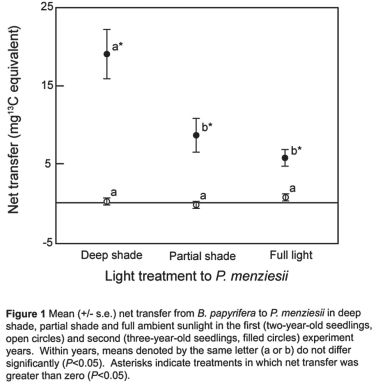
Use the following information when answering the corresponding question(s) .
Suzanne Simard and colleagues knew that the same mycorrhizal fungal species could colonize multiple types of trees.They wondered if the same fungal individual would colonize different trees,forming an underground network that potentially could transport carbon and nutrients from one tree to another (S.Simard et al.1997.Net transfer of carbon between mycorrhizal tree species in the field.Nature 388:579-82) .Figure 31.2 illustrates the team's experimental setup.Pots containing seedlings of three different tree species were set up and grown under natural conditions for three years;two of the three species formed ectomycorrhizae (Douglas fir,birch) and the other (cedar) formed arbuscular mycorrhizae.For the experiment,the researchers placed airtight bags over the Douglas fir and birch seedlings;into each bag,they injected either carbon dioxide made from carbon-13 or carbon-14 (¹³CO₂ and ¹⁴CO₂,isotopes of carbon) .As the seedlings photosynthesized,the radioactive carbon dioxide was converted into radioactively labeled sugars that could be tracked and measured by the researchers.
Figure 31.2

Figure 31.3

-Simard et al(1997) further hypothesized that if reciprocal transfer did occur,it would be a source-sink relationship driven by photosynthetic rates.That is,if one seedling is in full Sun and the other in deep shade,there will be a net movement of carbon from the seedling in full Sun to the one in deep shade.If a shade was placed over the birch seedlings and the cedar,and the Douglas fir was left in full Sun,what result could Simard and colleagues expect?
A) More ¹³C would be found in the birch than in the Douglas fir.
B) More ¹³C would be found in the Douglas fir than in the birch.
C) The most ¹³C would be found in the cedar.
D) The most ¹⁴C would be found in the cedar.
Correct Answer:
Verified
Q1: Based on the idea that fungi have
Q27: Figure 31.5
Use the graphs in Figures 31.4
Q28: Use the following information when answering the
Q29: Microsporidians are considered parasitic because of the
Q30: Figure 31.4
Use the following information when answering
Q32: Figure 31.5
Use the graphs in Figures 31.4
Q33: Figure 31.4
Use the following information when answering
Q34: Many amphibian populations have been decimated by
Q35: Some fungal species can kill herbivores while
Q36: Figure 31.4
Use the following information when answering
Unlock this Answer For Free Now!
View this answer and more for free by performing one of the following actions

Scan the QR code to install the App and get 2 free unlocks

Unlock quizzes for free by uploading documents